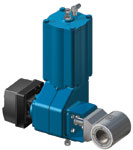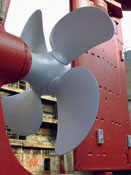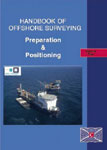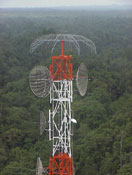
|
Vol. 227 No. 9 |
Laser-based moisture analyzer
SpectraSensors, Inc., has introduced a new moisture analyzer technology that outperforms traditional gas sensors. The laser-based analyzer can obtain consistently accurate readings on wet gas. Unaffected by the contaminants in natural gas streams, especially wet ones, the natural gas analyzer offers a precision alternative to the problems of inaccurate and slow measurements that can result in excessive treatment costs or shut-ins. Using a “tunable-diode” laser-based technology, the analyzer accurately monitors moisture content by precisely measuring the absorbance of light by moisture molecules, thereby measuring the exact amount of water (or carbon dioxide). There are no chemical conversions involved, and no natural gas sensor contact with the sample gas. This eliminates “coating” problems, erratic measurements, and exceeded tariffs.
|
Lightning protection system
|
|
| |
Modern instrumentation, including PCs, servers, sensors, integrated circuits, and programmable logic controllers (PLCs) are minutely sensitive to the enormous electrical transients of lightning and its secondary effects, such as electromagnetic pulse (EMP), which can destroy hardware, corrupt data and disrupt processes. Antiquated lightning rod technology was never intended to protect computer equipment or electronic process control systems. Lightning rods are designed to attract lightning and conduct it to ground, which may be a poor choice in the vicinity of sensitive electronic equipment.
Lightning Eliminators and Consultants, Inc. (LEC), based in Boulder, Colorado, is at the forefront of Dissipation Array System (DAS) development, a charge-transfer technology product that is a preventive solution for modern lightning protection. DAS essentially prevents strikes by continually lowering the voltage differential between the ground and charged storm clouds to well below lightning potential even in worst-case storms. The system has cut storm-induced voltages down to less than 2% within the protected zones compared to unprotected surroundings, eliminating the lightning strike risk. Over 35 years, the system has accumulated over 33,000 system-years of history with 99.85% no-strike performance. DAS have been installed in 55 countries worldwide, and has been used to protect facilities as large as three sq km and structures as high as 1,700 ft. An engineered solution typically involves: consultation; lightning attraction and collection for protection, or charge dissipation for strike prevention; grounding systems; and transient voltage surge suppression (TVSS). DAS are structurally engineered to withstand the harshest conditions anywhere on earth, and can be installed in many different specialized configurations.
|
|
|
|
|
|
Erosion-resistant control valves
 Metso Automation’s Neles E Series ceramic-lined ball valve, using a new generation of ceramic material, provides the most erosion-resistant control valve currently available. Completely lining the flow path, the magnesia partially stabilized zirconia (Mg-PSZ) is superior to more common ceramics, making it suitable for a wide range of severe-service industrial applications. The valve is suited for abrasive applications such as lime mud control, kaolin, china-clay control, calcium carbonate handling, gypsum handling, cement production, metal slurries, catalyst regeneration, desulphurization units, etc. Features include: resistance to mechanical and thermal shock, total erosion resistance with a completely ceramic-lined flow path without metal parts, and rigid stainless steel single-piece body that withstands pressure loads and pipeline forces to protect the ceramic material. The ball-to-stem connection is strong, with a backlash-free blade joint design, eliminating lost rotation between the ball and stem. It also features live loaded, double set of PTFE V-ring packing to minimize fugitive emissions and eliminate the need for packing adjustment. High tensile strength, 450 Mpa, can be considered close to steel. Metso Automation’s Neles E Series ceramic-lined ball valve, using a new generation of ceramic material, provides the most erosion-resistant control valve currently available. Completely lining the flow path, the magnesia partially stabilized zirconia (Mg-PSZ) is superior to more common ceramics, making it suitable for a wide range of severe-service industrial applications. The valve is suited for abrasive applications such as lime mud control, kaolin, china-clay control, calcium carbonate handling, gypsum handling, cement production, metal slurries, catalyst regeneration, desulphurization units, etc. Features include: resistance to mechanical and thermal shock, total erosion resistance with a completely ceramic-lined flow path without metal parts, and rigid stainless steel single-piece body that withstands pressure loads and pipeline forces to protect the ceramic material. The ball-to-stem connection is strong, with a backlash-free blade joint design, eliminating lost rotation between the ball and stem. It also features live loaded, double set of PTFE V-ring packing to minimize fugitive emissions and eliminate the need for packing adjustment. High tensile strength, 450 Mpa, can be considered close to steel.
Drilling operations suite
Decision Dynamics Technology Ltd.’s Wellcore software platform for upstream oil and gas companies has integrated drilling support with well-lifecycle management. The upgrade enables real-time visibility of all departmental functions from initial prospect to well abandonment, while also linking that data with cross-department tools such as AFE, project planning, rig scheduling and electronic permit filing. This new bridge between drilling operations and well lifecycle management suites eliminates information silos, which can hamper smooth business execution and intelligent decision making. Benefits range from faster time to production and improved capital spending management to more efficient rig utilization, automated filing preparation and submission with an associated audit trail, and automated identification of problems such as scheduling conflicts and lack of permits. An optional extension to the platform’s new Integration & Collaboration Engine (I.C.E.) also allows users to integrate Wellcore with legacy databases such as financial and ERP systems to streamline information exchange for billing and other purposes.
Deepsea pipeline inspection
 GE’s Pipeline Solutions group has developed SmartScan Deep Sea, a new multi-diameter in-line inspection (ILI) tool for deep-sea pipelines. Located at depths of between 1,500 and 3,000 m, deep-sea pipelines are built to withstand extremely high pressures, and typically feature thicker walls than regular pipelines and include multi-diameter segments that are unpiggable using traditional ILI tools. GE developed SmartScan DS as part of its high-resolution Magnetic Flux Leakage (MFL) product portfolio. The tool’s collapsible structure enables it to navigate multi-diameter lines. It also employs a number of novel components and subsystems, including highly sensitive sensors, pressure-proof electronics and magnetic circuitry. GE’s Pipeline Solutions group has developed SmartScan Deep Sea, a new multi-diameter in-line inspection (ILI) tool for deep-sea pipelines. Located at depths of between 1,500 and 3,000 m, deep-sea pipelines are built to withstand extremely high pressures, and typically feature thicker walls than regular pipelines and include multi-diameter segments that are unpiggable using traditional ILI tools. GE developed SmartScan DS as part of its high-resolution Magnetic Flux Leakage (MFL) product portfolio. The tool’s collapsible structure enables it to navigate multi-diameter lines. It also employs a number of novel components and subsystems, including highly sensitive sensors, pressure-proof electronics and magnetic circuitry.
Large-scale oil blending
Jiskoot has developed a solution for the blending of heavy crude oil in the Gulf of Mexico using the latest InSight blender system. The system was developed for Bergesen Worldwide for use on their BW Enterprise FPSO, which will be reportedly the world’s largest when its conversion is completed. The FPSO will serve as a hub in the nine-platform Pemex “KuMaZa” development of the Ku, Maloob and Zaap fields and act as an export terminal, receiving unstabilized oil for stabilization and blending it with stabilized oil. Accurately blending the produced heavy 13°API crude oil with lighter 21 – 35°API crude to optimize the value and specification of the export crude, the system is a two-stream blender with on-line density measurement designed to accurately blend a 16 – 21°API crude oil at up to 800,000 bbl per day. The InSight blend controller uses on-line measurement to continually optimize final product quality. By being integrated with the FPSO’s Emerson DeltaV control system, the real-time non-PLC control system also achieves a second objective of implementing a “maintenance on demand” system on the entire vessel. To guarantee accurate density measurement and ensure that the final product is homogeneous, a JetMix system used in the blend header is mixes across a wide range of flowrates with no pressure drop. This, along with ultrasonic flow meters and careful component selection, allows blender design to be optimized for a maximum pressure drop of less than 1.5 bar.
Rudder and propeller protection
 Ecospeed from Subsea Industries is a new hull-coating product that provides long-lasting protection of rudders and propellers. Ecospeed consists of glass platelets suspended in a reinforced vinylester resin, forming a complete protective barrier around the material it covers, making it virtually impenetrable. Unlike earlier glass particle coating technology, Ecospeed uses larger glass platelets specially designed to resist water ingress in the marine environment. It is the only commercially available homogenous hull protection system that resists cavitation and corrosion for many years. Once coated with Ecospeed, rudders and propellers are completely shielded from all corrosive elements in their operational environment. They are electrically inert, preventing the de-alloying process and so increasing service life. Mechanically, cavitation damage is virtually eliminated, saving on repairs and maintenance, and also increasing service life. Because of the smooth surface conditions, propellers operate at maximum efficiency and have self-cleaning properties, reducing fuel consumption. Ecospeed from Subsea Industries is a new hull-coating product that provides long-lasting protection of rudders and propellers. Ecospeed consists of glass platelets suspended in a reinforced vinylester resin, forming a complete protective barrier around the material it covers, making it virtually impenetrable. Unlike earlier glass particle coating technology, Ecospeed uses larger glass platelets specially designed to resist water ingress in the marine environment. It is the only commercially available homogenous hull protection system that resists cavitation and corrosion for many years. Once coated with Ecospeed, rudders and propellers are completely shielded from all corrosive elements in their operational environment. They are electrically inert, preventing the de-alloying process and so increasing service life. Mechanically, cavitation damage is virtually eliminated, saving on repairs and maintenance, and also increasing service life. Because of the smooth surface conditions, propellers operate at maximum efficiency and have self-cleaning properties, reducing fuel consumption.
Offshore surveying manual
 The Handbook of Offshore Surveying from Skilltrade deals specifically with the world of offshore surveying. In two volumes, it focuses on survey and related systems for data acquisition and positioning. It is aimed at both professional surveyors and those indirectly involved with surveying such as engineers, geo-scientists, mariners and managers. It provides practical theoretical knowledge with regard to problems likely to be encountered by personnel in the field or during the planning phase of a survey project. It provides the background to specify, operate and assess modern survey systems under real-world conditions. The book is a result of a collaboration between a number of hydrographic surveyors and geoscientists, each with his own specific field of expertise. All examples were taken from actual situations encountered in the field in their experience as surveyors. The Handbook of Offshore Surveying from Skilltrade deals specifically with the world of offshore surveying. In two volumes, it focuses on survey and related systems for data acquisition and positioning. It is aimed at both professional surveyors and those indirectly involved with surveying such as engineers, geo-scientists, mariners and managers. It provides practical theoretical knowledge with regard to problems likely to be encountered by personnel in the field or during the planning phase of a survey project. It provides the background to specify, operate and assess modern survey systems under real-world conditions. The book is a result of a collaboration between a number of hydrographic surveyors and geoscientists, each with his own specific field of expertise. All examples were taken from actual situations encountered in the field in their experience as surveyors.
|



 Metso Automation’s Neles E Series ceramic-lined ball valve, using a new generation of ceramic material, provides the most erosion-resistant control valve currently available. Completely lining the flow path, the magnesia partially stabilized zirconia (Mg-PSZ) is superior to more common ceramics, making it suitable for a wide range of severe-service industrial applications. The valve is suited for abrasive applications such as lime mud control, kaolin, china-clay control, calcium carbonate handling, gypsum handling, cement production, metal slurries, catalyst regeneration, desulphurization units, etc. Features include: resistance to mechanical and thermal shock, total erosion resistance with a completely ceramic-lined flow path without metal parts, and rigid stainless steel single-piece body that withstands pressure loads and pipeline forces to protect the ceramic material. The ball-to-stem connection is strong, with a backlash-free blade joint design, eliminating lost rotation between the ball and stem. It also features live loaded, double set of PTFE V-ring packing to minimize fugitive emissions and eliminate the need for packing adjustment. High tensile strength, 450 Mpa, can be considered close to steel.
Metso Automation’s Neles E Series ceramic-lined ball valve, using a new generation of ceramic material, provides the most erosion-resistant control valve currently available. Completely lining the flow path, the magnesia partially stabilized zirconia (Mg-PSZ) is superior to more common ceramics, making it suitable for a wide range of severe-service industrial applications. The valve is suited for abrasive applications such as lime mud control, kaolin, china-clay control, calcium carbonate handling, gypsum handling, cement production, metal slurries, catalyst regeneration, desulphurization units, etc. Features include: resistance to mechanical and thermal shock, total erosion resistance with a completely ceramic-lined flow path without metal parts, and rigid stainless steel single-piece body that withstands pressure loads and pipeline forces to protect the ceramic material. The ball-to-stem connection is strong, with a backlash-free blade joint design, eliminating lost rotation between the ball and stem. It also features live loaded, double set of PTFE V-ring packing to minimize fugitive emissions and eliminate the need for packing adjustment. High tensile strength, 450 Mpa, can be considered close to steel. GE’s Pipeline Solutions group has developed SmartScan Deep Sea, a new multi-diameter in-line inspection (ILI) tool for deep-sea pipelines. Located at depths of between 1,500 and 3,000 m, deep-sea pipelines are built to withstand extremely high pressures, and typically feature thicker walls than regular pipelines and include multi-diameter segments that are unpiggable using traditional ILI tools. GE developed SmartScan DS as part of its high-resolution Magnetic Flux Leakage (MFL) product portfolio. The tool’s collapsible structure enables it to navigate multi-diameter lines. It also employs a number of novel components and subsystems, including highly sensitive sensors, pressure-proof electronics and magnetic circuitry.
GE’s Pipeline Solutions group has developed SmartScan Deep Sea, a new multi-diameter in-line inspection (ILI) tool for deep-sea pipelines. Located at depths of between 1,500 and 3,000 m, deep-sea pipelines are built to withstand extremely high pressures, and typically feature thicker walls than regular pipelines and include multi-diameter segments that are unpiggable using traditional ILI tools. GE developed SmartScan DS as part of its high-resolution Magnetic Flux Leakage (MFL) product portfolio. The tool’s collapsible structure enables it to navigate multi-diameter lines. It also employs a number of novel components and subsystems, including highly sensitive sensors, pressure-proof electronics and magnetic circuitry. Ecospeed from Subsea Industries is a new hull-coating product that provides long-lasting protection of rudders and propellers. Ecospeed consists of glass platelets suspended in a reinforced vinylester resin, forming a complete protective barrier around the material it covers, making it virtually impenetrable. Unlike earlier glass particle coating technology, Ecospeed uses larger glass platelets specially designed to resist water ingress in the marine environment. It is the only commercially available homogenous hull protection system that resists cavitation and corrosion for many years. Once coated with Ecospeed, rudders and propellers are completely shielded from all corrosive elements in their operational environment. They are electrically inert, preventing the de-alloying process and so increasing service life. Mechanically, cavitation damage is virtually eliminated, saving on repairs and maintenance, and also increasing service life. Because of the smooth surface conditions, propellers operate at maximum efficiency and have self-cleaning properties, reducing fuel consumption.
Ecospeed from Subsea Industries is a new hull-coating product that provides long-lasting protection of rudders and propellers. Ecospeed consists of glass platelets suspended in a reinforced vinylester resin, forming a complete protective barrier around the material it covers, making it virtually impenetrable. Unlike earlier glass particle coating technology, Ecospeed uses larger glass platelets specially designed to resist water ingress in the marine environment. It is the only commercially available homogenous hull protection system that resists cavitation and corrosion for many years. Once coated with Ecospeed, rudders and propellers are completely shielded from all corrosive elements in their operational environment. They are electrically inert, preventing the de-alloying process and so increasing service life. Mechanically, cavitation damage is virtually eliminated, saving on repairs and maintenance, and also increasing service life. Because of the smooth surface conditions, propellers operate at maximum efficiency and have self-cleaning properties, reducing fuel consumption. The Handbook of Offshore Surveying from Skilltrade deals specifically with the world of offshore surveying. In two volumes, it focuses on survey and related systems for data acquisition and positioning. It is aimed at both professional surveyors and those indirectly involved with surveying such as engineers, geo-scientists, mariners and managers. It provides practical theoretical knowledge with regard to problems likely to be encountered by personnel in the field or during the planning phase of a survey project. It provides the background to specify, operate and assess modern survey systems under real-world conditions. The book is a result of a collaboration between a number of hydrographic surveyors and geoscientists, each with his own specific field of expertise. All examples were taken from actual situations encountered in the field in their experience as surveyors.
The Handbook of Offshore Surveying from Skilltrade deals specifically with the world of offshore surveying. In two volumes, it focuses on survey and related systems for data acquisition and positioning. It is aimed at both professional surveyors and those indirectly involved with surveying such as engineers, geo-scientists, mariners and managers. It provides practical theoretical knowledge with regard to problems likely to be encountered by personnel in the field or during the planning phase of a survey project. It provides the background to specify, operate and assess modern survey systems under real-world conditions. The book is a result of a collaboration between a number of hydrographic surveyors and geoscientists, each with his own specific field of expertise. All examples were taken from actual situations encountered in the field in their experience as surveyors.
